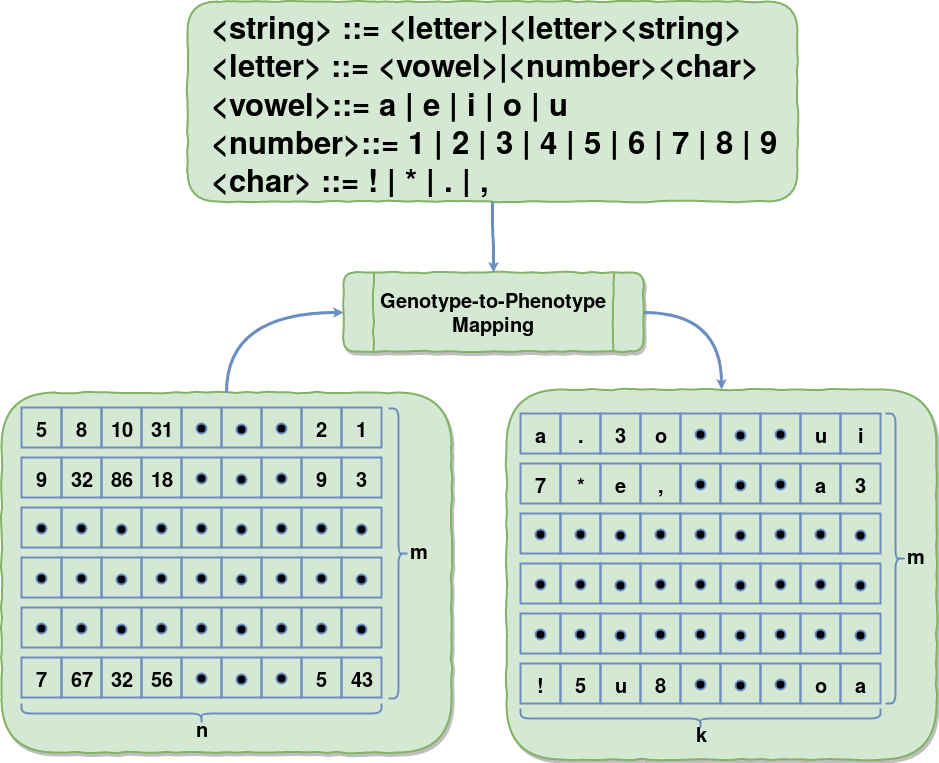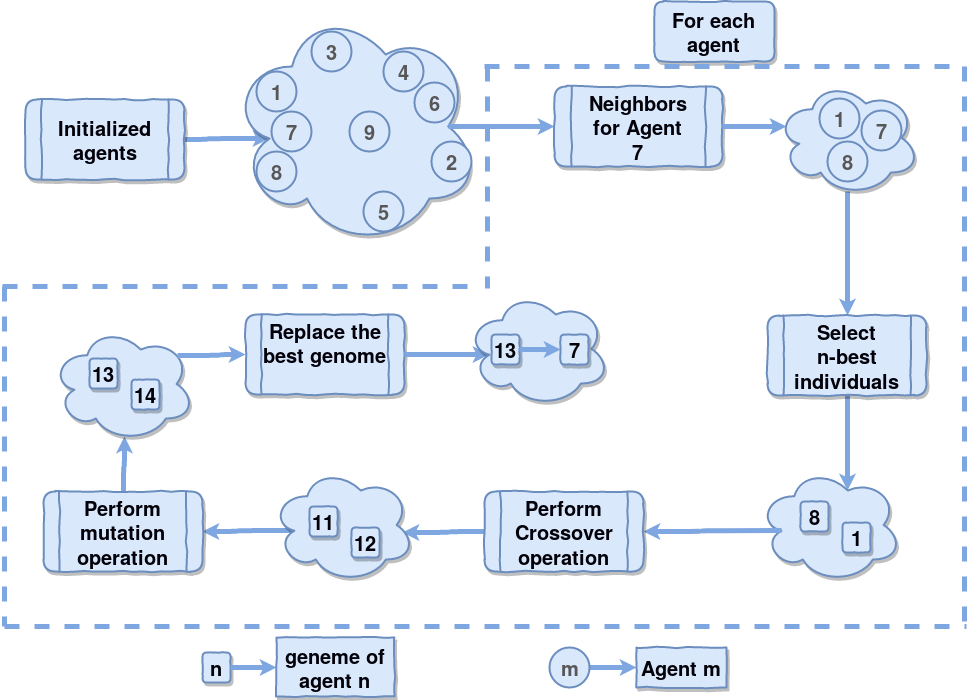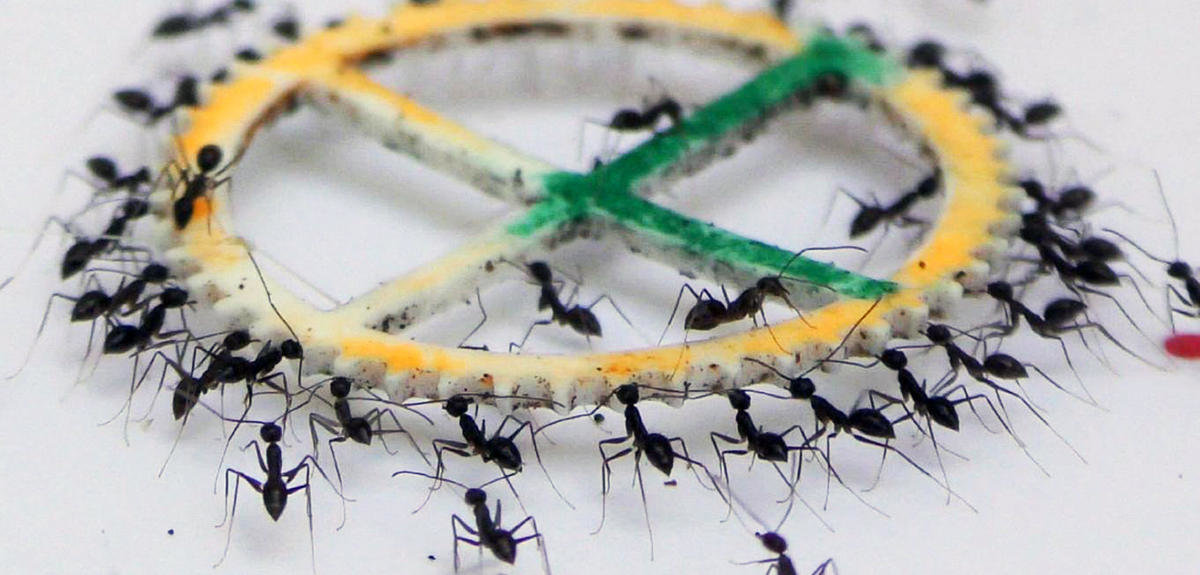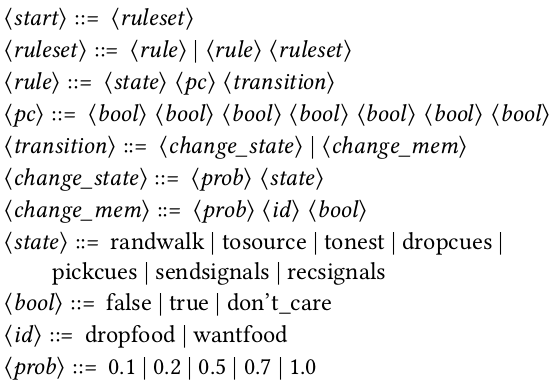Emergence of Collective Behaviors in Hub-Based Colonies using Grammatical Evolution
Aadesh Neupane
Problem
- Design collective behaviors is cumbersome
- Requires experts for modeling
Solution
- Evolutionary computation to generate collective behaviors
$$\frac{dR}{dt} = -aR + vnD , R(0) = R_0$$
$$\frac{dO}{dt} = aR -bO +cE, O(0) = O_0$$
$$\frac{dE}{dt} = q(D)bO - cE, E(0) = E_0$$
$$\frac{dA}{dt} = p(D)bO - mA + wnD$$
$$\frac{dD}{dt} = mA - nD, D(0) = D_0$$
Reference: Stability of choice in the honey bee nest-site selection process

Presentation Structure
- Thesis Statement
- Related Work
- Evolutionary Robotics
- Neural Nets
- Distributed Evolution
- Grammatical Evolution
- Genotype
- Santa Fe Trail
- Mapping
- Evolutionary Robotics
- GEESE
- Validation
- Effectiveness
- Robustness
- Breadth
Thesis Statement
The interaction of hundreds of agents within the framework of distributed grammatical evolution will increase the effectiveness of evolving collective behaviors of bio-swarms. The evolved behaviors can be reused for different collective problems that have similar properties. Furthermore, with a slight variation of the objective function, the same set of primitive behaviors, encoded in the grammar, can lead to collective behaviors over a wider range of collective problems.
Related Work - Evolutionary Robotics
Reference: Evolution of collective behaviors for a real swarm of aquatic surface robots
- Swarm behaviors like homing, dispersion, clustering and monitoring by Duarte et. at
- Validation of scalability, flexibility, and robustness on transferred controller
Neural Network based controllers
Merits
- Easy mapping from sensory inputs into actuators values
- Provides generalized solutions
- Only a few human inputs needed
Demerits
- Issues with reverse engineering
- Insights on collective behavior difficult
- Almost impossible to modify the behaviors
Related Work - Evolutionary Robotics
Reference: Evolution of collective behaviors for a real swarm of aquatic surface robots
Neural Network based controllers
Related Work - Evolutionary Robotics
Reference: GESwarm: Grammatical Evolution for the Automatic Synthesis of Collective Behaviors in Swarm Robotics
- Foraging problem using GE by Ferrante et. al.
- Preconditions, low-level behavior and actions gave behaviors
Grammatical Evolution (GE) based controllers
Advantages
Disadvantages
- BNF grammar and objective function
- Analyzing and modifying collective behaviors easier
- Primitive low-level rules defined by experts
- Mapping to raw sensors and actuators values difficult
Related Work - Distributed Evolution
Reference: odNEAT: An algorithm for distributed online, onboard evolution of robot behaviours
odNEAT
- Online distributed evolution of Neural networks
- Applicable for online learning in groups of embodied agents (robots)
- Performs well in aggregation task
Combination of best features from all these works?
- An online distributed Grammatical Evolution
Related Work - Grammatical Evolution
BNF Grammar
Population of Genome
Corresponding Phenotype

Grammatical evolution: Evolving programs for an arbitrary language
Grammatical Evolution
BNF Grammar
<code> ::= <code> | <progs>
<progs> ::= <condition> | <prog2> | <prog3> | <op>
<condition> ::= if_food_ahead(<progs>, <progs>)
<prog2> ::= prog2(<progs>, <progs>)
<prog3> ::= prog3(<progs>, <progs>, <progs>)
<op> ::= left | right | move
- Santa Fe Trail
- Represented by tuple \(N, T, P, S\)
- N -> Set of all non-terminals
- T -> Set of all terminals
- P -> Set of productions that map \(N\) to \(T\)
- S -> Initial start symbol
Grammatical Evolution
Santa Fe Trail

- Objective
- Find all food using maximum of 600 moves
- 32 x 32 cells
- Optimal trail
- 144 cells
- 89 food
- 55 gaps
- Actions :
- Left
- Right
- Forward
Grammatical Evolution
Genome/ Genotype / Individual

- Defines the proceedings of left-derivation
- \({Codon}\) is a group of symbols, usually 4 or 8.
Grammatical Evolution - BNF Grammar
Mapping
- Let \(c\) be codon integer
- \(A\) denotes the left-most non-terminal in the derivation
- \(r_A\) denotes the number of right-hand side rules associated with the production of \(A\)
-
RHSRule = \(c\%r_A\)
Phenotype
- The output from the mapping process is the phenotype
- The phenotype represents a valid expansion of the BNF grammar
- \(if\_food\_ahead(move, left)\)
Example of Grammatical Evolution
RHSRule = \(c\%r_A\)
<code> ::= <code> | <progs>
<progs> ::= <condition> | <prog2> | <prog3> | <op>
<condition> ::= if_food_ahead(<progs>, <progs>)
<prog2> ::= prog2(<progs>, <progs>)
<prog3> ::= prog3(<progs>, <progs>, <progs>)
<op> ::= left | right | move


Grammatical Evolution
GE Pipeline

GEESE


















GEESE





Hello! Neighbour!
How are you doing with the phenotype in this environment?
Hello!
I collected 35 oz of water with the phenotype.
Take my genome and perform magic using genetic operators !
GEESE Pipeline

Swarm Behaviors
- Primitive Behaviors
- Function that maps the set of sensor values to actuator commands
- Behaviors as state-machine or behavior trees
- Examples
- GO_TO_HUB
- FOLLOW_LIGHT
- SEND_SIGNAL
Thesis Statement
The interaction of hundreds of agents within the framework of distributed grammatical evolution will increase the effectiveness of evolving collective behaviors of bio-swarms. The evolved behaviors can be reused for different collective problems that have similar properties. Furthermore, with a slight variation of the objective function, the same set of primitive behaviors, encoded in the grammar, can lead to collective behaviors over a wider range of collective problems.
Validation
| Claim | Metric |
|---|---|
| Effectiveness | Quality solutions in fewer generations |
| Robustness | Same behavior for both single and multiple foraging problem |
| Breadth |
Solutions for Foraging and cooperative transport problem |
Validation

Effectiveness
Validation
Robustness



Evolved BT
Single Source Foraging problem
Multiple Source Foraging problem
Validation
Breadth



Swarm BNF Grammar
Foraging problem
Cooperative Transport problem
Acknowledgement
This work has been funded by ONR grant number N000141613025.
Thank You!
proposal-thesis
By Aadesh Neupane
proposal-thesis
Thesis proposal
- 652



